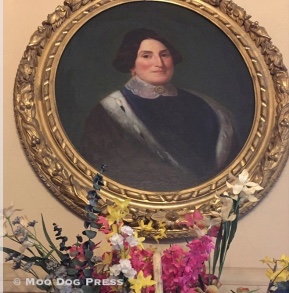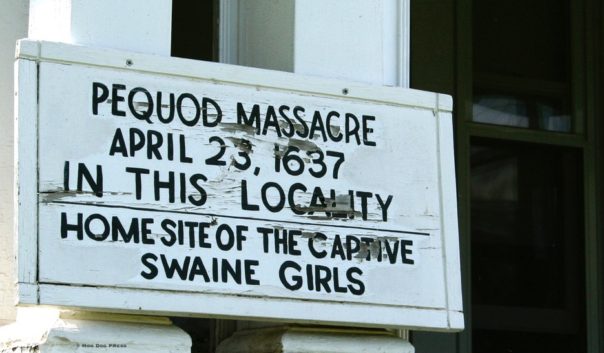Then and Now Walk: ‘Indian Girl’ Remembered, Riverport Russells
Remember me. (Yes. Most certainly will.)
Is history important? It’s unseen unless brought to light, put into context, made understandable. People who changed the community for the better – such as Mrs. Russell – fade into history. Context may be lost, forgotten. With ever-shorter attention spans, events can sometimes light the spark to get people out walking and looking – trying new things. Finding connections. Learning about why this place is important, different.
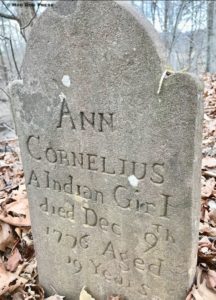
Not forgotten, although her gravestone is at the farthest reaches of a burying grounds. Inscription for Ann Cornelius as cared on this simple stone: “a Indian girl…1776, age 19 years.”
The Russell House is an important architectural structure now owned by Wesleyan University, a gift, actually. So notable, that it listed in the Historic American Buildings Survey/Historic American Engineering Record/Historic American Landscapes Survey and part of Historic American Buildings Survey (Library of Congress).
People connect to their communities by going on walks, seeing interpretive signs to help them understand what they are looking at, many like a guided tour. Tourism can be an economic driver to a place or region as well. Middletown, Connecticut is on the Connecticut River and is home to a vibrant multi-cultural Main Street, hosts to an active chamber of commerce – and is the location of Wesleyan University, a world leader in education and innovation, culture, history, writing. The student body is from around the planet, parents visit, stay, explore local and regional restaurants and sites of interest.
For example, while checking out books at The Russell Library (Middletown), overhead conversation about “The Witch of Blackbird Pond” – librarian to mothers checking out books – because that book is, of course, set in a real place, Old Wethersfield, Connecticut. (If you haven't read it, bring a copy and plan a day trip – this portion of town features wide sidewalks, great independent eateries, and much history – very important to what happened at Yorktown.)
The conversation began with general delight in reading books that included local features such as West Rock in New Haven (CT). The patrons had arms full of young adult (YA) books.
When they left, commented that the “Witch” book is indeed superb, and that Old Wethersfield is full of stories and interesting places to visit, explore. The librarian then spoke of having gone on a tour of an “ancient cemetery” in Old Wethersfield and shared details about what she remembered. About how knowledge of botany and herbal medicines could get a person labeled a witch. Or that suspicions raised could destroy a person who others did not like – such as a newcomer.
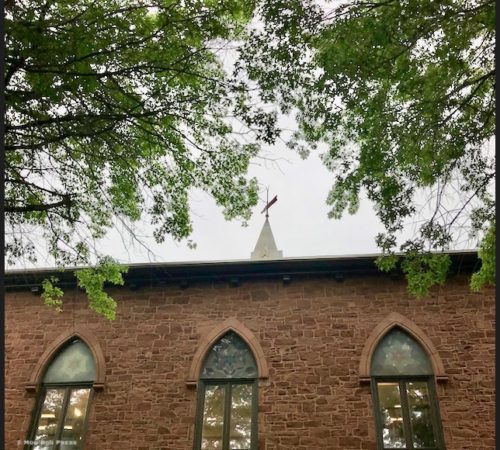
Built-of-brownstone Russell Library and weathervane detail. Yes, Mrs. Russell founded and gave this library as a gift and legacy to the community and city.
She then commented that Middletown (CT) had been a vibrant riverport, had a storied history of shipping and world trade – yet hardly anyone knew about it. That young readers and her own children had little interest in it. There was not much material available in town about this aspect of it.
Russell. Russell Library. The Russell House. Russell Company. The Russell Chapel at Indian Hill Cemetery. A bell. So what's the story behind this name that keeps occurring throughout a riverport city known as Middletown, Connecticut?
A very human one, turns out.
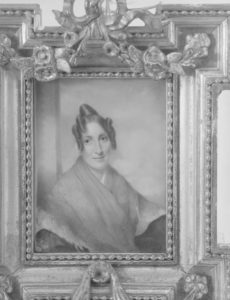
Mrs. Samuel Russell (Frances Ann Osborne) by Henry Colton Shumway (1807–1884), watercolor on ivory. Dale T. Johnson Fund, 2006; digital collection of The Metropolitan Museum of Art. Not currently on view. Look into her eyes – choices she made changed a community.
“Frances Russell established Russell Library in 1875 in memory of her husband, Samuel. The Episcopal Church of the Holy Trinity had built the building on the corner of Broad and Court Streets in 1834, and Mrs. Russell purchased and remodeled it in the Roman Gothic Style. The building opened as the public library for the City of Middletown on April 5, 1876. In 1930, the City helped to add the Hubbard wing, and in 1972 completed the remodeled Children’s Library, originally the First Federal Saving and Loan Association of Meriden, built in 1965.
“In 1983, an architectural firm expanded the library greatly, meeting the challenge of combining two disparate buildings. Two of the original stained glass windrows were reinstalled in the new main peak and in the children’s area.” – Russell Library
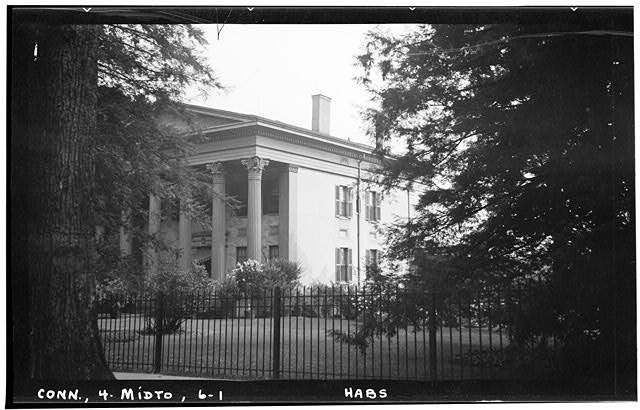
Historic American Buildings Survey Thomas T. Waterman, Photographer 1936 – Samuel Russell House, 350 High Street, Middletown, Middlesex County, CT. Repository: Library of Congress (LOC) Prints and Photographs Division Washington, D.C.
Excerpt about the structure known as The Russell House: Architect – David Hoadley. Description: Brownstone. The portico of Greek Corinthian columns is said to have been intended for the Eagle Bank at New Haven, which was never finished. The house is perhaps the most perfect temple-form dwelling in this country and is notable for its excellent proportions and fine detail. Additional data: Russell was a wealthy merchant who traded with China and the East Indies. The property was presented by the Russells to Wesleyan University in 1936. Reference: Connecticut Guide, p. 206. Prepared by Thomas T. Waterman 1940
Here is the story about the chapel and connections to the community from our archives (the title is linked to the full story, 2017):
High On A Hill Heritage, Human History: Indian Hill And The Russell Chapel
When asked about The Russell House (deeded to Wesleyan University by the Russell family), she replied, “Hence the Russell Library” and gestured to where we both stood, a gift to the city from Mrs. Russell. Asked her if she knew about the brownstone chapel at Indian Hill Cemetery was also due to Mrs. Russell — who had it built in memory of her husband? The librarian was unaware of the connection.
Librarians are people who deal in information and knowledge, connection and community. And yet, here was someone quite learned but unaware of a local landmark with national connections to history and heritage. This provoked more thoughts.
“Few are aware that, in 1867, Middletown's Frances Russell donated the Gothic Revival Chapel in memory of her late husband Samuel Russell. Samuel Russell was an American entrepreneur and trader who founded Russell & Company in Canton, China. While he was in China, Samuel's first wife, Mary, died, leaving their sons, George and John Russell. Mary's sister, Frances Osborne, cared for the children for several years until their father's return. When he returned to Middletown, Samuel married Frances. Later, the family increased when Samuel and Frances were blessed with a son, Samuel Wadsworth Russell.”
– from history of Indian Hill
Hmm. Here's more. Seems one person decided to make a difference in her own way – and the long-term cultural legacy is pretty amazing. A book could be written about her life for a city enriched by her decision, directing funds to build, create, remember others.
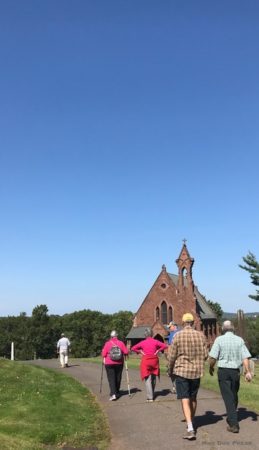
The past and present together. Tom Russell (left) walks with UConn Arborist John Kehoe and others on a recent tree tour walk. The Meneely bell can be seen in the belltower of the Russell Memorial Chapel in the background, built and donated by Frances Russell, in memory of her late husband, Samuel Russell.
The bell in the Russell Memorial Chapel has a voice that hasn't been heard in the community for 75 years. And it is a famed Meneely foundry bell. The public is invited to hear it peal on Saturday, Oct. 5 at noon. But there's more to this story, and it stems back to a family known as the Russells.

Part of the handsome brownstone wall for the Russell family memorial that is currently being restored.
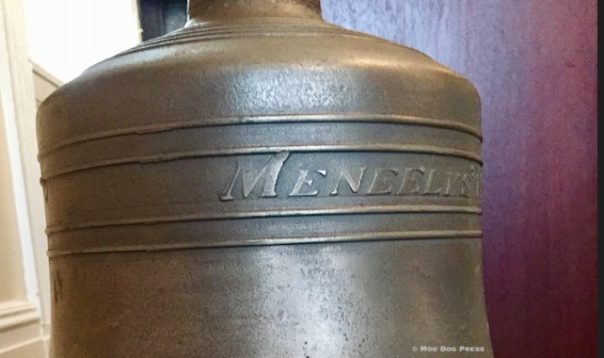
Original Meneely bell, forged in Troy, New York, 1868; restored. Note its home in the bell tower of the Russell Chapel.
Which leads back to the original overheard conversation in October 2017. (Writers listen to all going on around them, except while writing when time stops and the world falls away. There is only the flow and trying to get the words out.)
When asked if the librarian knew about the captive Swaine sisters – taken from Old Wethersfield on an Indian raid – she said no. Then queried “Were they returned okay?”
That's a story for another day.
Here's a little bit about the Meneely Foundry in New York: “From 1808 until 1951, four foundries in and across the river from Troy cast and shipped bells to destinations all over the world. The following excerpt from Hudson Mohawk Gateway: An Illustrated History by Thomas Phelan describes the region’s bell industry:
‘The greatest name in Gateway bells was undoubtedly that of Andrew Meneely. At 17, he was apprenticed to Julius Hanks and even married one of Hanks’ daughters. In 1826 he founded his own firm in Gibbonsville. Meneely is credited with the invention of the ‘conical rotary yoke,’ later catalogued as ‘the most desirable and perfect rotary yoke in the world.’ His firm remained a family-held, single-product business for well over a century, casting some of the most important bells, pads, and chains used in this country and abroad.'
“Some of these important bells include: a replacement for the original Liberty Bell (cast in 1876 for the Centennial) that hangs today in the bell tower of Independence Hall, Philadelphia. This is not a replica of the original bell. Rather, it is a much larger bell, weighing 13,000 pounds, a thousand pounds for each of the original 13 States. Four bells on the Metropolitan Life Insurance Tower in New York City. According to Sydney Ross in his Gateway booklet entitled The Bell Casters of Troy: “These bells are 700 feet in the air, and are by far the highest hung bells in the world. Their sound has been reported by voyagers at sea, beyond Sandy Hook, New Jersey, fully 28 miles from the tower, and by others on Hudson River boasts, equally as far to the north.”
“To this day, there are Meneely bells on every continent on the planet except Antarctica.”
Source: hudsonmohawkgateway.org/bells.html
Note: Portions of this story have been previously published. Related, a link to see the Russell Company building.

